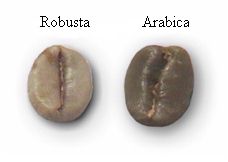Coffee Plant Agriculture
Coffee plants belong to the botanical genus Coffea in the family
Rubiaceae, which has 500 genera and over 6,000 species.
Although there is some disagreement, the number of species
belonging to Coffea ranges from 25 to 100.
 Most
commercial green coffee is either the C. arabica
or C. canephora species, which is referred to commercially
as Arabica and Robusta, respectively. Coffea arabica
is an allotetraploid inbreeder (2n = 44). Forty
to fifty cultivars (infraspecific taxa) are known, and are
suspected to be derived from two cultivars of C. arabica
being var. arabica (including var. typica) and var.
bourbon.
Most
commercial green coffee is either the C. arabica
or C. canephora species, which is referred to commercially
as Arabica and Robusta, respectively. Coffea arabica
is an allotetraploid inbreeder (2n = 44). Forty
to fifty cultivars (infraspecific taxa) are known, and are
suspected to be derived from two cultivars of C. arabica
being var. arabica (including var. typica) and var.
bourbon.
Arabica Coffee
Arabica coffee is grown at altitudes over 2,000 (usually 4,000-6,000) feet
above sea level and is typically harvested by hand when
the cherries are perfectly ripe. Robusta has continued
its share in the market due to its disease resistance and
ability to grow below 2,000 feet. Robusta beans are
inferior to Arabica beans in flavor, and they are often
used in inexpensive instant coffee blends. Robusta
coffee has almost twice the caffeine of Arabica coffee.
Italians often will use a very small amount of Robusta coffee
to increase crema and to tone down the acidity of the Arabica
coffees.
A coffee cherry
consist of four layers which are removed sequentially. The
coffee bean is the seed of the coffee cherry and is covered
with silverskin, parchment, pulp, and then an outer skin
layer. The method of removal of these layers dramatically
alters the flavor.
Main
Articles:
Coffee
Plant
Coffee
Harvesting
Coffee
Processing
Fertilization
Diseases


